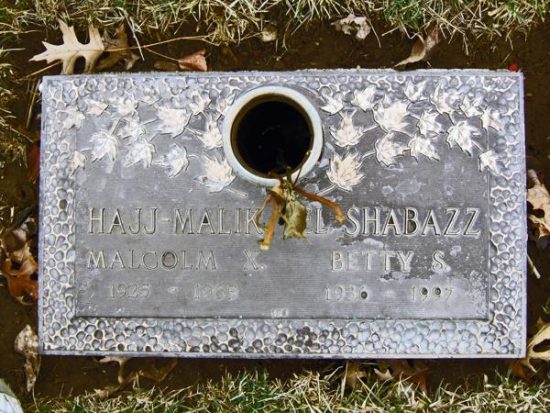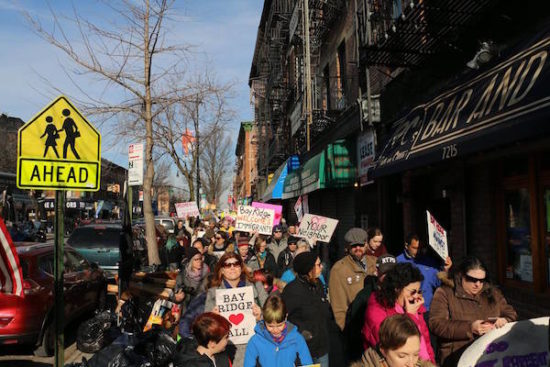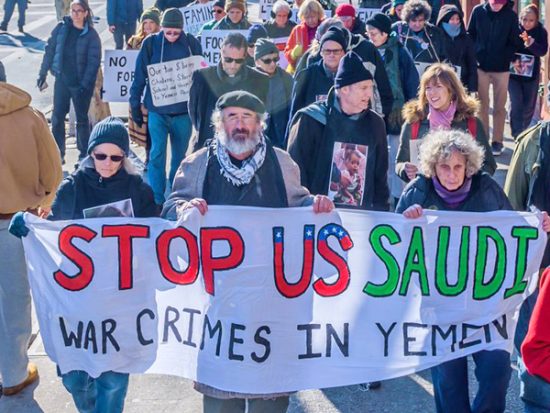The members of the Union of Arab Women are graduating with diplomas, a spirit of activism, and a new family.

November 1, 2017
The Arab immigrant population in the United States is largely comprised of Christians and Egyptian Jews. Some of the earliest Arab Christians who arrived in New York from Syria and The Levant did so in the 1800s — they were fleeing persecution by the Ottomans. Little Syria, a vibrant and bustling neighborhood of cafes and markets, evolved in Lower Manhattan along Washington Street. In the 1940s, however, the settlement was displaced by the Battery Tunnel and the Syrian population moved to Bay Ridge. The descendants of this established population of early Arab Christian migrants continue to live along the waterfront in Bay Ridge. Muslim Arab migration is far more recent and newer immigrants have settled for the most part in the working class neighborhoods around Fourth and Fifth Avenue.
Census maps indicate Bay Ridge to be 88 percent white, classifying Arabs as Caucasians. But in actuality, it is predominantly Middle Eastern and North African and in need of services that were either removed or never delivered due to the misrepresentation of census data. In 2010, the Arab American Association of New York (AAANY) ran a campaign: Check it Right. You Ain’t White. The success of this effort will be reflected in the 2020 census that will include a box titled MENA for people of Middle Eastern and North African origin.

“This idea of being included and seeing yourself in a government document is a big deal for our community,” stated Linda Sarsour, the former executive director of AAANY, at a Ford Foundation convening on Islamophobia in February 2016. “If you don’t exist on a graph, then you don’t exist.” Unless immigrant communities are accurately reflected in census data, they miss out on funding and other resources.
There are 3.3 million Muslims in the United States, according to the Pew Research Center. Twelve percent of the entire Muslim population nationwide lives in the New York region and of this, three percent make their home in New York City. Straddling distinct cultures and continents, Muslims, nevertheless, find themselves in the unique position of occupying polar extremes on the spectrum of visibility in America—hyper-scrutinized and perceived through a national security and terrorism lens on the one hand, and painfully invisible on the other, when it comes to data and services.
My visits to AAANY have shown me a predominantly Arab Bay Ridge where visibly Muslim women populate the markets and sidewalks. But while there may be safety in numbers, visibility also makes for an easy target. Muslim women in Bay Ridge have been spat on, kicked, yelled at, and had their hijabs pulled.
“We started our self-defense workshops a year ago,” says Somia, an advocacy trainer and founder of the Union of Arab Women, as we walk back together from Beit Al Maqdis to the AAANY office in what has come to feel now like a ritual. “You heard about the imam who was killed last summer? And the Indian woman who was attacked? In our community, a boy was at the masjid on 53rd Street when people tried to attack him with knives. This was last Ramadan. Things are happening a lot. But we want to empower our women, support them, teach them how to defend themselves, be confident, not be scared to dress according to their culture and religion.”
Today, Noha joins us on our walk after the self-defense workshop. Noha is a community organizer at AAANY and her area of focus is advocacy, outreach and youth programming. The conversation circles around identity: what it means to be Arab-American. Born and raised in New York—her parents came here in the 80s from Egypt—Noha confides, “It’s a struggle! Honestly, it depends on who you’re talking to. They say, ‘Where are you from?’ I’m like, Staten Island. ‘No, no, where are you from?’ I’m just like—Egypt!” she laughs. “It really depends.”
“Back in our countries, it isn’t easy to speak out. That’s the biggest thing that makes Arab people move to the United States of America—we are looking for freedom. We are trying to find freedom here!”
Growing up, Noha’s Arabic was stronger than her English. Her mother “enforced” the Arabic language and culture at home so much so that at school Noha would find herself translating into Arabic to make sense of the English. “I think I still identify more with my Arab side.”
I ask Somia if her decade in the United States and her work at AAANY has triggered a shift in identity.
“Actually, I’m Arab,” she replies matter-of-factly. “I still have my ideas and culture from my country. I can’t change that. I would love to teach my culture to my daughters, and granddaughters in the future, because this is who we are! At the same time, it’s up to us to learn about the culture here. We’re living here now.”
“But to be American, doesn’t it also mean that you can still identify with your own culture— it’s not one or the other, right?” I say.

“This is the thing that makes America really special,” Somia’s voice rises in excitement. “To find many different religions and cultures in the same place, and everyone loves each other! In the Union of Arab Women, the thing is, we are Arab but we have so many different cultures. Back in our countries, it isn’t easy to speak out. That’s the biggest thing that makes Arab people move to the United States of America—we are looking for freedom. We are trying to find freedom here!”
“Bay Ridge to me feels very Arab,” I say.
It isn’t the food markets, the jewelry and abaya stores, or the signs in Arabic calligraphy, nor the pervasive sound of Arabic on the street, or even the sight of women in hijab and niqab that make me say this. It’s the inconspicuous yet palpable warmth of greetings exchanged by strangers, the unadorned hospitality at, for instance, Yemen Café, where the waiters refuse to charge for a cup of spiced sweet tea—subtle mannerisms and gestures of the heart, culturally familiar to me from years in the Middle East.
Somia grins. “Even the Chinese food here is halal!”
——————
“Thank God, I didn’t end up voting for Trump!” Sana, an intern at AAANY, confides. “I thought what he said about Mexicans and immigrants was a joke. There’s no way he’s going to do this, I thought, he’s just posing. He was the cool guy, the guy on TV who said, ‘You’re fired!’ But then… he did get the vote. This proves to me there is a great deal of hatred and people will go through with it.”
We are sitting in the lobby of the Beit El-Maqdis Islamic Center, talking about what it means to be Arab-American in today’s political climate, if the hyphenated identity really means anything at all, and if so, which side of the hyphen has greater pull.
“You were actually seriously considering voting for him?” I say, unable to conceal my shock.
“Yeah! Because I thought Hilary was also just like him. I remember I told my dad, ‘They’re all the same, they’re all going to have the same politics.’”
Sana is petite, with a youthful demeanor and her conversation is sprinkled with subtle humor. Born in Brooklyn to Yemeni parents, she chose to wear hijab starting in the fifth grade.
“I was a grade behind because I went to visit Yemen. There was this kid named Israel in my class who kept making jokes about me. I didn’t have a smart tongue. He’d make these clever jokes and I’d just beat him up. I didn’t know how else to respond,” she laughs.
“My dad’s a light person. ‘Just don’t bother,’ he said. But he didn’t explain it to me either. It wasn’t until the Intifada in 2000 that I really grasped what was going on. I was one of those kids who was sheltered and when things did happen, I brushed them off, until you realize you can’t brush off everything anymore.”
“I guess I’m starting to realize that I should be aware of my culture and background. Because now, I don’t know what being American means anymore.”
Until she’d experienced that first sting of discrimination, Sana thought she was just like everyone else. “My family’s really Americanized. But we do practice our religion. My teenage sister thinks she’s Goth. She covers, but ‘I have to wear black’ she says. She has to wear the t-shirt that says, ‘I Don’t Care!’ My dad’s like, ‘Please find yourself quickly because you’re annoying me!’ All her friends are the same.”
A mother of two young children, Sana had a traditional wedding and was married to a man from Yemen. “I brought my husband to this country. He is an immigrant,” she says. “In the beginning, he was culture-shocked and I was shocked! I’m so Americanized, it was a struggle. But we’ve come a long way.”
Weeks after the election, Sana’s cousin showed her a photo of a swastika that had been graffitied near their home. For the first time, she felt fearful. “Shouldn’t we buy a house in Yemen, just in case, as a backup?” she called her father.
On a recent visit to Baltimore, Sana was reminded, once again, that she was perceived as other. At the swimming pool, a Caucasian woman came up to Sana and her aunt. “You know you’re free in this country. You can take that off.”
“My aunt said, ‘Since, I’m free, I choose to wear this.’” Sana sweeps her hand in a gesture to indicate a fully-clad body.
Later that evening, at a restaurant, Sana’s extended family sensed all eyes on them when her son started crying. “I was being watched. My son was being watched. The woman at the next table, I could see that she couldn’t just look at me like another mom with a baby. I guess they aren’t used to seeing Muslims. I feel we are in a bubble here in Bay Ridge. We dress alike, we look alike. In Baltimore, I had a very different experience.”
“If someone asks you where you’re from, how do you respond?”
“I’m American! I always say that. But now, sometimes, I do say I’m Yemeni. I haven’t grasped this yet. I don’t know how to yet.”
“Do you think that will change?” I ask.
“I guess I’m starting to realize that I should be aware of my culture and background. Because now, I don’t know what being American means anymore.”
——————
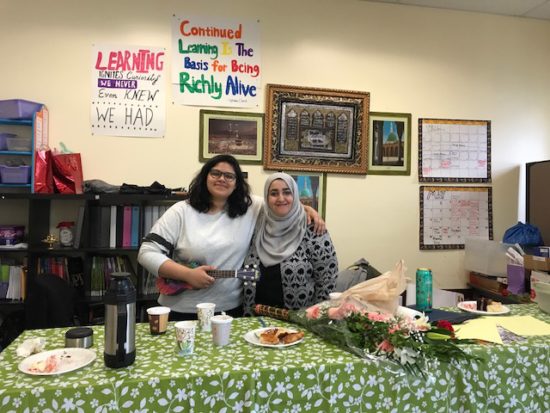
The minute I open the metal and glass doors of Beit El-Maqdis Islamic Center on the morning of April 25, everything tells me this day is unlike any other. A cloud of oudh fragrance wafts over from a large silver incense burner planted by the door containing bukhoor woodchips. There is a hush and sheen in the hall, and the lobby is cleared of extra furniture, brooms and books that otherwise meet the eye on entering. It’s Graduation Day; 20 women will receive certificates in recognition of their successful completion of a three-month long advocacy course. Several others will receive certificates acknowledging their work and volunteer service at AAANY. For the first time, the entire event has been organized by members of the Union of Arab Women (and not AAANY staff), rendering it extra special.
I spot Linda Sarsour, dressed in a mustard-gold coat and matching headscarf, mingling with students and staff. A few seats to my left is Dr. Ahmed Jaber, co-founder of AAANY and a retired Ob-Gyn, who serves as an imam, or spiritual leader, in the larger community, having evolved into this latter role out of a need to fill the gap of an English-speaking imam in the city. Silence descends on the room and a melodious recitation of Quranic verses by a member of the Union of Arab Women opens the graduation ceremony. Speeches in English follow, extolling the virtues of both the advocacy program and the Union of Arab Women.
“I really want to thank Somia … for her effort to support and empower. She always inspires us and reminds us how important it is to be a strong Arab woman, to know your rights and speak out!”
“Somia—great thanks!” says the next speaker. “You are a sister, teacher, inspirer and comrade! The family at AAANY thanks you.”
“The advocacy program and the Union of Arab Women have empowered us and made us visible. There’s nothing wrong with being a strong woman! I hope that every woman in our community will join and find herself. Thank you, Somia, for inspiring us!”
It is Somia’s fourth work anniversary. Speaker after speaker lauds her for her warmhearted and stalwart leadership and the hall thunders with applause as she receives a bright bouquet of flowers.
“You are not students. You are family… my sisters!” Somia exclaims, keeping comments brief as she thanks students and staff members.
Next unfolds a lively skit enacting a street scene. A woman in an abaya, pushing her shopper-on-wheels, accidentally grazes a pedestrian’s foot, eliciting a shouting fury. “I hate you! Go! Leave! Go back to your country!” The distraught woman offers an earnest apology, then becomes frightened by the increasing vehemence. A passerby comes to her aid and informs her about AAANY and the resources and support available to her.

“Oh my God!” Linda Sarsour says in a voice filled with wonder as she walks up to the floor and looks around the hall. She slips into Arabic, then moments later, switches to English. “I am very proud of this organization. And I’m very proud of Dr. Jaber. Because Dr. Jaber is a man; an Arab man. He’s also an imam. And he supported me and believed in me. And it’s because of Dr. Jaber and his support that I am who I am today… I want to thank all my staff here, who every day serve this community. They work long hours, don’t ask for anything in return, and I hope they know how much we appreciate them. We’re truly a family here. And I will always be part of the AAANY family.”
A short raffle quiz follows. As numbers are picked from a jar, ticket holders answer questions, the first of which— “Who is Humayra?”—elicits a look of confusion. Three tries and still the answer remains elusive. I chuckle to myself and Dr. Jaber leans over and says, “They should say a few words about Aisha so people know.” (Aisha is the Prophet’s wife, dear to him, and to whom he gave the pet name Humayra, meaning red, as in the red-cheeked one). The second and third questions are also related to Islamic history—“Who was the first martyr of Islam?”—and I am struck by how integral religion is to the community. Rather than pop cultural, culinary or political references, as one might expect, the raffle quiz focuses on Islamic history and the life of the Prophet, perhaps because it is faith that ultimately binds the various Arab cultures represented in the group— and the assumption that all present are Muslim.
Names are called out and one by one the graduates come up to receive their certificate and a red rose. There is excitement in the air; a couple of women brush away tears. After the ceremony, everyone gathers around a table laden with Arabic sweets and tea.
Dr. Jaber, dressed in a suit and beige beret, is standing pensively to the side observing the scene with an expression of discreet pride when I walk up to him.
“Today is one of those days that makes me feel the impact that we’ve had on our community,” he says. “I think of all the progress we’ve made when I see all these women taking leadership roles, educating and empowering themselves and navigating a foreign system in a new language. That’s what AAANY is for—to tell them they are important, that they can reach their goals, and we give them the opportunity to do so through learning English, through showing how you can lead the community as a mother, as a woman, as an advocate for your culture, for yourself. It’s a great feeling! And I am so proud.”
“This is my family! This is where my activism was born—AAANY shaped my world views, allowed me to talk to and touch refugees, and to listen to their experiences of fleeing war and conflict.” – Linda Sarsour
AAANY’s outreach and impact have grown dramatically—presently the organization serves 5,000 clients a year. With Linda at the helm, Dr. Jaber informs me, AAANY’s women’s leadership and advocacy program have catapulted to national visibility.
“In her remarks, Linda thanked you for your support and drew attention to the fact that you are an imam,” I say. “It isn’t typical for an imam to be so supportive of women, is it? At least that is the perception the general public has.”
Dr. Jaber shakes his head. “True scholars know that Islam reveres women and defends their rights! It’s the culture that is imposed and which overlooks the rights given to women in the religion,” he says. “But the United States is an open society and here there are opportunities for women—it recognizes women’s impact.”
Before retiring, Dr. Jaber was delivering babies, serving as an imam and working as an activist all at the same time. While some imams won’t perform a wedding ceremony if a Muslim marries out of the faith, Dr. Jaber says he is always happy to venture beyond—“because I feel it’s important to reach out to communities who aren’t aware and to spread the word.”
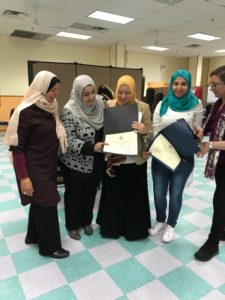
I spot Linda in the middle of the hall, speaking with a group of non-Arab guests at the graduation and inch my way in to the conversation.
“For me it’s always overwhelming to see the women up there receiving their certificates!” she admits. “These are women who never stand in front of a room with dozens of people watching them. Many of them are from Yemen and Syria, conflict-ridden communities. And here they are with a new family at AAANY, building sisterhood!
“I was moved by their words,” she tells me. “Many were talking about how, ‘I’ve never felt so encouraged and motivated in my life!’ It means a lot to me to see the women who are like my older sisters—some of them the age of my mother— saying this. That’s exactly what my work is—I want people to feel worthy and loved.”
When I remark that her work takes her all over the country, yet she still manages to find time to be very present in Bay Ridge, Linda declares:
“This is my family! This is where my activism was born—AAANY shaped my world views, allowed me to talk to and touch refugees, and to listen to their experiences of fleeing war and conflict. And Dr. Jaber, one of the founders of AAANY and an Ob-gyn, actually delivered me— he was the first person to hold me! That’s how community-oriented this organization is! I will always be part of it because that’s where I became who I am.”
I watch Azza and Weam gather the graduates for a group photo. The excitement of the ceremony and the joy of achievement, so palpable in the hall, enter my veins. There is truly something “magical” about close-knit community, I muse, remembering Somia’s description.
“Actually, I cried during the ceremony,” Somia admits when I eventually catch up with her in a rare moment of quiet. “Seeing how independent the women have become, and how they spoke in front of everyone and did a skit! I remember how shy they were. They never wanted to speak in class or share anything about their backgrounds. There are some really strong women here who remained unseen until they learned their rights.”
Congratulating Somia, I ask, ‘How do you feel on your fourth work anniversary?”
“I feel happy that the women I worked with so closely appreciate the things I’ve done with them,” she says, eyes shining. “Alhamdulillah! I feel I have done something meaningful. I really feel my value at work. It really, really made me feel like crying!” she laughs.
——————
Read Part 1: These Streets are Ours Too
Read Part 2: Your Kids Need Hub! They Need Love
Read Part 3:Working Together As One Hand

